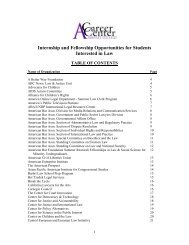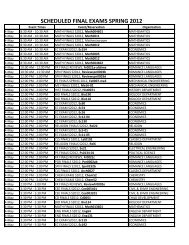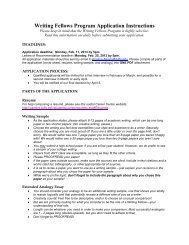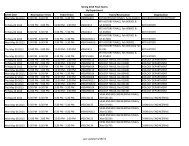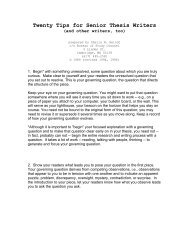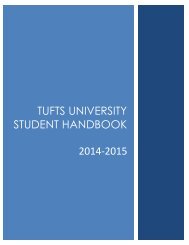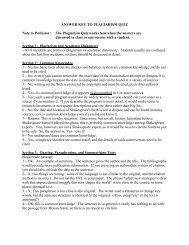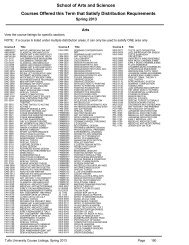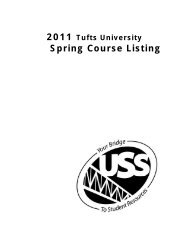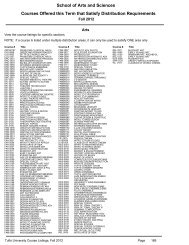S P R I N G 2 0 1 3 - USS at Tufts - Tufts University
S P R I N G 2 0 1 3 - USS at Tufts - Tufts University
S P R I N G 2 0 1 3 - USS at Tufts - Tufts University
Create successful ePaper yourself
Turn your PDF publications into a flip-book with our unique Google optimized e-Paper software.
Course ListingsFall 2012Studio Art - Medford CampusFAM 0003ART AS PROCESSThis course is for individuals who want to transform and develop theirartistic practice and visual awareness. Art as Process is an intensivestudio class th<strong>at</strong> focuses on experiment<strong>at</strong>ion and the cre<strong>at</strong>ive processr<strong>at</strong>her than a pre-imagined or calcul<strong>at</strong>ed end product. Each week adifferent project will be introduced, worked on and completed. We willexplore painting, drawing, sculpture, install<strong>at</strong>ion and other disciplinesand media with an eye toward investig<strong>at</strong>ing unique ways of making art.Abstraction, Realism and Conceptual approaches will be addressedand explored through a variety of hands-on projects. Individual andcollabor<strong>at</strong>ive exercises will challenge students to broaden theirawareness of personal and assimil<strong>at</strong>ed beliefs, conceptual ideas andautobiographical content through the use of metaphor, symbol andunconventional media. Class discussions, readings, present<strong>at</strong>ions andfield trips will supplement studio practice and look <strong>at</strong> art making incontext of historical, cultural and contemporary issues. The interactive,particip<strong>at</strong>ory n<strong>at</strong>ure of Art as Process enables students coming fromdiverse areas of study to expand and enrich their perspectives of thebroader community. Open to all, from absolute beginners to advancedartists, Art as Process is particularly useful for those interested inexploring and developing their own cre<strong>at</strong>ive abilities, assembling aportfolio or exploring the idea of a professional art career.Sections01886 FAM 0003B ARR Hull, K<strong>at</strong>a 0.5 Meets Fri9:30-12:30 PmFAM 0005CALLIGRAPHYThis course introduces both a way of seeing line, form and space andthe basics of design through pen-drawn letters. Concentr<strong>at</strong>ing on thebasic Italic letterforms and touching on the Square Roman capitals,emphasis will be on developing rhythm and freedom of line, as well aslayout and design. Several projects exploring the expressivepossibilities of contemporary calligraphy will be completed during thesemester.Please see departmental website for specific details:http://www.smfa.edu/Continuing_Educ<strong>at</strong>ion/Studio_Art_Courses_Open_to_<strong>Tufts</strong>_Students.aspSections01887 FAM 0005A ARR Broman-wright, 1.0 Tue & Thu7:00-10:00 P.m.FAM 0006CALLIGRAPHY IIIn this course, which is a continu<strong>at</strong>ion of the first semester ofCalligraphy, the Roman Capitals will be studied more fully throughprojects emphasizing spacing and proportions. This will be followed bythe cre<strong>at</strong>ion of a personal capital letter design through rapid writing andthe possible use of non-traditional writing tools. Other scripts will alsobe studied based on historic examples and utilized in cre<strong>at</strong>ive projectsusing color and decor<strong>at</strong>ion. As a culmin<strong>at</strong>ion of the semester's work,students will design, write and bind a manuscript book. Continuedcourses may be taken for credit for an unlimited number of times.Sections01888 FAM 0006A ARR Broman-wright, 1.0 Fam 5/tue &Thu 7:00 -10:00 P.m.FAM 0020DESIGN FOUNDATIONThe design process involves the development of skills as a conceptualand visual problem solver. Using the essential elements of design togive form to ideas, you will explore the use of line, shape, texture, grid,color, typography and other elements to solve graphic problems anddevelop your voice as a visual storyteller. A variety of media as well asthe computer will be included to explore the principle guidelines forbuilding composition, learning how to make design choices and expandyour cre<strong>at</strong>ive problem solving abilities, design vocabulary and technicalskills. This course addresses design consider<strong>at</strong>ions such as use ofspace, scale, emphasis, symmetry and other elements of image andform. A basic understanding of design principles and history is aresource for understanding how design affects our daily lives. This is anexcellent program for anyone working in, or just starting out, in thevisual arts.Sections01889FAM 002001 ARR Breiner, Joanne 1.0 Mon & Wed1:30-4:30 PmFAM 0021DESIGN:INTER TO ADVThis course is a continu<strong>at</strong>ion of Design: Found<strong>at</strong>ion (FAM 0020) and isintended for the serious student who wants to develop 2-D and 3-Ddesign skills. Elements of design encountered in Design: Found<strong>at</strong>ionwill be re-examined to see how they can be used in new situ<strong>at</strong>ions,including commercial applic<strong>at</strong>ions. The use of a variety of media andparticip<strong>at</strong>ion in critiques is encouraged. Continued courses may betaken for credit an unlimited number of times.Please see departmental website for specific details:http://www.smfa.edu/Continuing_Educ<strong>at</strong>ion/Studio_Art_Courses_Open_to_<strong>Tufts</strong>_Students.aspSections01890 FAM 002101 ARR Breiner, Joanne 1.0 Fam 20/mon &Wed 1:30-4:30PmFAM 0022DESIGN:ARCHITECTURALThis course offers an introduction to architectural design through anintensive studio experience. In the design studio, work is advancedprimarily by independent student explor<strong>at</strong>ion and guided by criticaldiscussions with the instructor, guest critics, and the studio <strong>at</strong> large. Anumber of lecture present<strong>at</strong>ions and demonstr<strong>at</strong>ions introduce keytopics, but much of the learning and growth relies on active discussionsof the collective body of studio work. You will learn how to abstractlyanalyze, represent, and cre<strong>at</strong>e space through a series of designprojects th<strong>at</strong> increase in complexity and dur<strong>at</strong>ion throughout thesemester. Your work will incorpor<strong>at</strong>e drawing and modeling techniques,concept development, sp<strong>at</strong>ial thinking, multi-scalar awareness, programanalysis, context analysis, and many other layers of the architecturaldesign process. The studio takes advantage of Boston as a primaryresource by visiting relevant local works of architecture, <strong>at</strong>tending locallectures in architecture, and accessing local architecture libraries, all ofwhich open the studio's boundaries to the broader contemporary designworld. This is a high-demand course: applic<strong>at</strong>ions are available in theDepartment of Art and Art History, 11 Talbot Ave.Prerequisites: Students are strongly encouraged to take <strong>at</strong> least onecollege level architectural history or art history course, as well as astudio art course.Sections01891 FAM 0022A ARR Hutchinson, Reb 1.0 By Applic<strong>at</strong>ionAt Art History11 Talbot AveFAM 0023DESIGN:ARCHITECTURAL ADVThis course builds upon the found<strong>at</strong>ional knowledge th<strong>at</strong> is covered inthe introductory level and aims to achieve a higher degree ofarchitectural design sophistic<strong>at</strong>ion through a series of projects. Thesedesign challenges increase in complexity and dur<strong>at</strong>ion over the courseof the semester. You are expected to have advanced skills in drawingand model making, which enable you to devote your time to developingand critiquing your own design process. You will delve deeper intoissues of context, form, and space, and you will be expected to drawupon previous design work from rel<strong>at</strong>ed courses such as architecturalhistory, architectural engineering, urban planning, sculpture, drawing,and others. The studio takes advantage of Boston as a primaryresource by visiting relevant local works of architecture, <strong>at</strong>tending locallectures in architecture, and accessing local architecture libraries, all ofwhich open the studio's boundaries to the broader contemporary designworld. This course is intended for students who have already takenFAM 22 or its equivalent <strong>at</strong> another institution. This is a high-demandcourse: applic<strong>at</strong>ions are available in the Department of Art and ArtHistory, 11 Talbot Ave.Sections01892 FAM 0023A ARR Hutchinson, Reb 1.0 By Applic<strong>at</strong>ionAt Art HistoryDept.<strong>Tufts</strong> <strong>University</strong> Course Listings, Fall 2012Page 171



